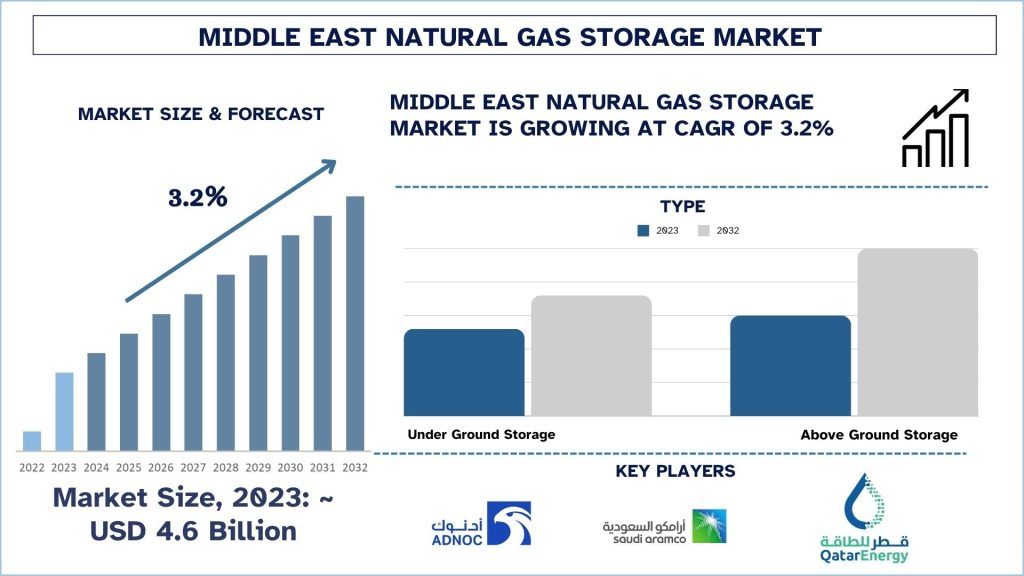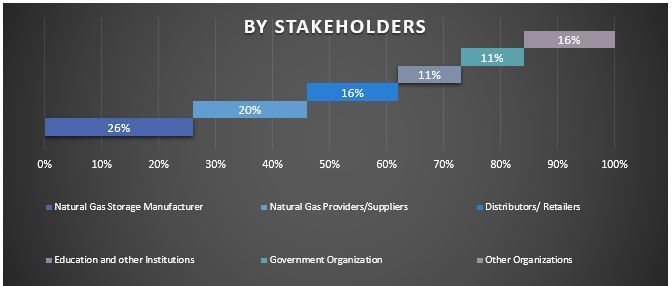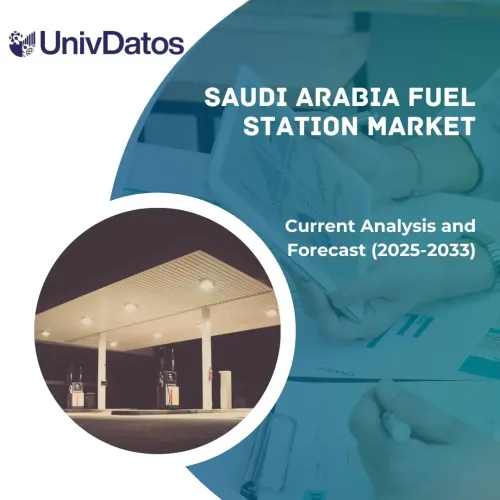Рынок хранения природного газа на Ближнем Востоке: текущий анализ и прогноз (2024-2032 гг.)
Акцент на типе (подземное хранилище и надземное хранилище); Страна
Объем рынка хранения природного газа на Ближнем Востоке оценивался в 4,6 миллиарда долларов США в 2023 году и, как ожидается, будет расти со среднегодовым темпом роста 3,2% в течение прогнозируемого периода (2024-2032 гг.).
Размер и прогноз рынка хранения природного газа на Ближнем Востоке
Объем рынка хранения природного газа на Ближнем Востоке оценивался в 4,6 миллиарда долларов США в 2023 году и, как ожидается, будет расти со стабильным среднегодовым темпом роста около 3,2% в течение прогнозируемого периода (2024-2032 гг.). Рынок хранения природного газа на Ближнем Востоке играет решающую роль в региональной энергетической системе из-за растущего спроса на энергетическую безопасность и неуклонного увеличения добычи природного газа. Поскольку регион остается неизменно крупным экспортером природного газа, такие страны, как Саудовская Аравия, ОАЭ, Катар и Иран, продолжают уделять первоочередное внимание развитию и росту своих запасов природного газа. Эти объекты помогают прогнозировать колебания спроса в течение года, стабилизируя поставки газа и улучшая экспорт сжиженного природного газа (СПГ). Рынок поддерживается хорошо развитой сетью существующей инфраструктуры подземного хранения, выработанных нефтегазовых месторождений и соляных куполов, что помогает удовлетворить внутреннее потребление, а также экспортный спрос.
Анализ рынка хранения природного газа на Ближнем Востоке
Правительства стран региона также уделяют особое внимание хранению природного газа для диверсификации энергетики, снижения зависимости от нефти и перехода к возобновляемым источникам энергии. Достижения в технологиях хранения в сочетании с ростом капитальных вложений со стороны отечественных и международных энергетических компаний еще больше подпитывают рост рынка. Кроме того, из-за геополитических факторов, существующих в глобальном масштабе, и неопределенности в поставках энергии страны Ближнего Востока улучшают свои хранилища.
Тенденции рынка хранения природного газа на Ближнем Востоке
Увеличение внутреннего спроса на энергию: Внутренний спрос на энергию является одним из основных факторов, которые привели к увеличению хранилищ природного газа на Ближнем Востоке. Стремление к быстрому развитию инфраструктуры и промышленному росту, особенно в Саудовской Аравии, ОАЭ и Катаре, которые являются основными странами, потребляющими энергию в регионе, в результате быстрой урбанизации и индустриализации, повысило спрос на эффективные источники энергии. Учитывая рост населения в сочетании с экономическим развитием, природный газ, используемый для производства электроэнергии, отопления и других промышленных процессов, стал еще более востребованным.
Таким образом, страны региона в настоящее время вкладывают много капитала в объекты по производству природного газа для удовлетворения этого спроса. В качестве примера можно привести план Саудовской Аравии «Видение 2030», направленный на развитие потребления природного газа в стране в качестве стратегии снижения зависимости от нефти. Что касается хранения, ОАЭ также улучшают хранение природного газа, чтобы удовлетворить растущий спрос на энергию в регионе и добиться баланса в его поставках в периоды высокого спроса. Подчеркивая необходимость увеличения существующих мощностей хранения, страны могут эффективно решать проблемы, связанные с распределением природного газа, предотвращать перебои с поставками и в конечном итоге способствовать энергетической безопасности.
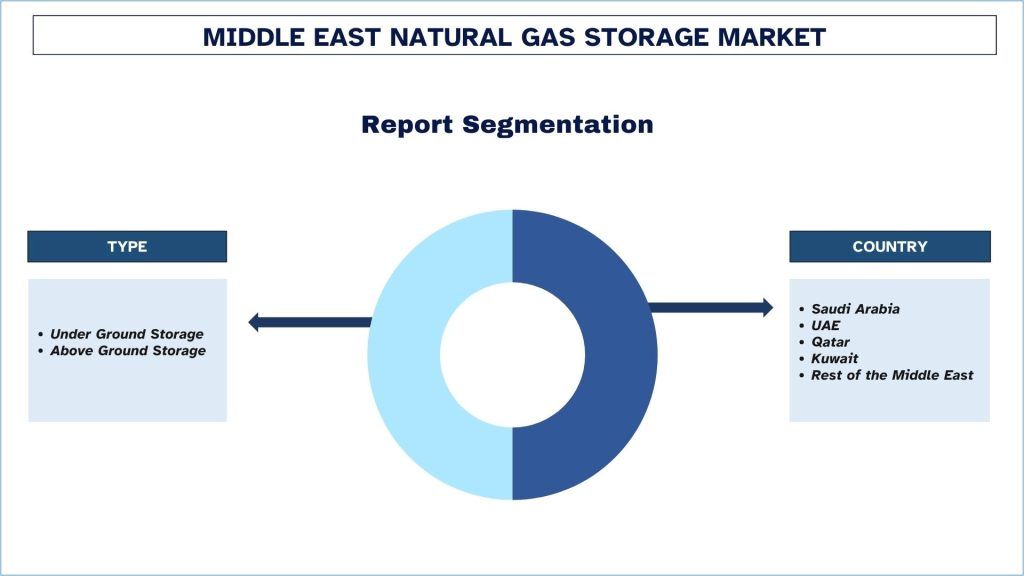
Ожидается, что Катар будет расти со значительным среднегодовым темпом роста в течение прогнозируемого периода
Катар оказывает значительное влияние на рыночный спрос на хранение природного газа на Ближнем Востоке. Это доминирование в основном связано с поставками природного газа, особенно с Северного месторождения, крупнейшего в мире месторождения природного газа, не связанного с нефтью. Природный газ является основным стратегическим ресурсом в экономике Катара, что позволяет стране занимать лидирующие позиции в мире по производству, экспорту и хранению СПГ с большими инвестициями как в сжижение, так и в хранение. Среди других стран Ближнего Востока, таких как Саудовская Аравия и ОАЭ, Катар также имеет огромное производство и хранение природного газа, но из-за его особой концентрации на природном газе, особенно на СПГ, и обильных доказанных запасах занимает первое место на рынке хранения природного газа на Ближнем Востоке.
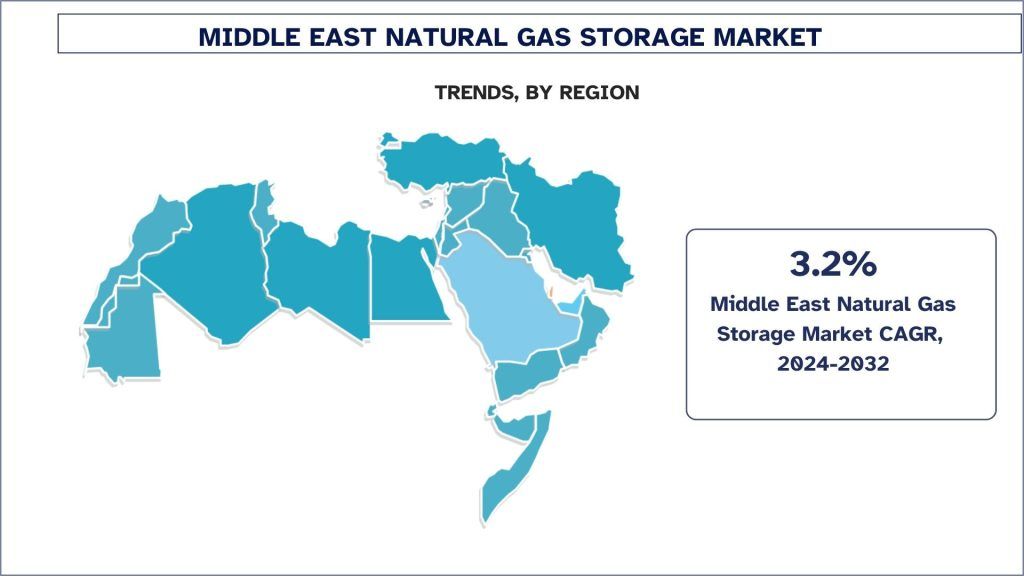
Обзор отрасли хранения природного газа на Ближнем Востоке
- Рынок хранения природного газа на Ближнем Востоке является конкурентным и фрагментированным, с присутствием нескольких игроков на рынке стран. Ключевые игроки применяют различные стратегии роста для расширения своего присутствия на рынке, такие как партнерства, соглашения, сотрудничество, запуск новых продуктов, географическая экспансия, а также слияния и поглощения. В число основных игроков, работающих на рынке, входят Abu Dhabi National Oil Company (ADNOC), Saudi Aramco, QatarEnergy, Kuwait Petroleum Corporation, Dana Gas, Oman Oil Company, Bahrain Petroleum Company (BAPCO), ExxonMobil Corporation, ENOC Group и TAQA.
Отчет об охвате рынка хранения природного газа на Ближнем Востоке
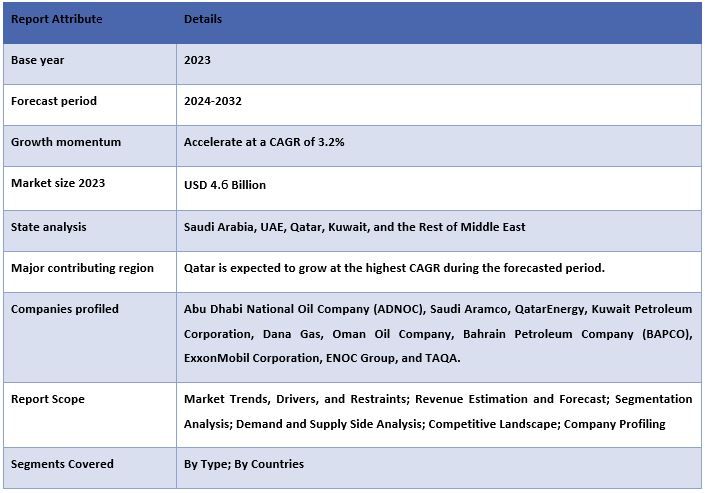
Причины купить этот отчет:
- Исследование включает в себя анализ размеров рынка и прогнозирование, проверенный аутентифицированными ключевыми экспертами отрасли.
- В отчете представлен краткий обзор общих показателей отрасли с одного взгляда.
- Отчет охватывает углубленный анализ видных представителей отрасли с уделением особого внимания ключевым финансовым показателям бизнеса, портфелям продуктов, стратегиям расширения и последним событиям.
- Подробное изучение движущих сил, ограничений, ключевых тенденций и возможностей, преобладающих в отрасли.
- Исследование всесторонне охватывает рынок по различным сегментам.
- Углубленный анализ отрасли на региональном уровне.
Варианты настройки:
Рынок хранения природного газа на Ближнем Востоке может быть дополнительно настроен в соответствии с требованиями или любым другим сегментом рынка. Кроме того, UMI понимает, что у вас могут быть свои собственные бизнес-потребности, поэтому не стесняйтесь обращаться к нам, чтобы получить отчет, который полностью соответствует вашим требованиям.
Содержание
Методология исследования анализа рынка хранения природного газа на Ближнем Востоке (2024-2032 гг.)
Анализ исторического рынка, оценка текущего рынка и прогнозирование будущего рынка хранения природного газа на Ближнем Востоке были тремя основными шагами, предпринятыми для создания и анализа внедрения хранения природного газа на Ближнем Востоке в основных странах. Было проведено исчерпывающее вторичное исследование для сбора исторических данных о рынке и оценки текущего размера рынка. Во-вторых, для подтверждения этих выводов было принято во внимание множество результатов и предположений. Кроме того, были проведены исчерпывающие первичные интервью с отраслевыми экспертами по всей цепочке создания стоимости рынка хранения природного газа на Ближнем Востоке. После предположения и проверки рыночных данных посредством первичных интервью мы применили подход «сверху вниз/снизу вверх» для прогнозирования полного размера рынка. После этого были приняты методы декомпозиции рынка и триангуляции данных для оценки и анализа размера рынка сегментов и подсегментов отрасли, относящихся к подробной методологии, которая объяснена ниже:
Анализ исторического размера рынка
Шаг 1: Углубленное изучение вторичных источников:
Было проведено подробное вторичное исследование для получения исторических данных о размере рынка хранения природного газа на Ближнем Востоке через внутренние источники компании, такие как годовые отчеты и финансовые отчеты, презентации о производительности, пресс-релизы и т. д., и внешние источники, включая журналы, новости и статьи, правительственные публикации, публикации конкурентов, отраслевые отчеты, сторонние базы данных и другие надежные публикации.
Шаг 2: Сегментация рынка:
После получения исторических данных о размере рынка хранения природного газа на Ближнем Востоке мы провели подробный вторичный анализ для сбора исторических данных о рынке и доли для различных сегментов и подсегментов для основных регионов. Основные сегменты, включенные в отчет, - это тип и страна. Был проведен дальнейший анализ на уровне страны для оценки общего внедрения моделей тестирования в этом регионе.
Шаг 3: Факторный анализ:
После получения исторических данных о размере рынка различных сегментов и подсегментов мы провели подробный факторный анализ для оценки текущего размера рынка хранения природного газа на Ближнем Востоке. Кроме того, мы провели факторный анализ, используя зависимые и независимые переменные, такие как тип рынка хранения природного газа на Ближнем Востоке. Был проведен тщательный анализ сценариев спроса и предложения с учетом ведущих партнерств, слияний и поглощений, расширения бизнеса и запуска продуктов в секторе рынка хранения природного газа на Ближнем Востоке по всей стране.
Оценка и прогноз текущего размера рынка
Определение текущего размера рынка: Основываясь на действенных выводах, полученных на основе вышеуказанных 3 шагов, мы пришли к текущему размеру рынка, ключевым игрокам на рынке хранения природного газа на Ближнем Востоке и долям рынка сегментов. Все необходимые процентные доли, разделения и декомпозиции рынка были определены с использованием вышеупомянутого вторичного подхода и проверены посредством первичных интервью.
Оценка и прогнозирование: Для оценки и прогнозирования рынка веса были присвоены различным факторам, включая драйверы и тенденции, ограничения и возможности, доступные для заинтересованных сторон. После анализа этих факторов были применены соответствующие методы прогнозирования, т.е. подход «сверху вниз/снизу вверх», для получения рыночного прогноза на 2032 год для различных сегментов и подсегментов на основных рынках Индии. Методология исследования, принятая для оценки размера рынка, включает в себя:
- Размер рынка отрасли с точки зрения дохода (доллары США) и темпов внедрения рынка хранения природного газа на Ближнем Востоке на основных рынках внутри страны
- Все процентные доли, разделения и декомпозиции сегментов и подсегментов рынка
- Ключевые игроки на рынке хранения природного газа на Ближнем Востоке в отношении предлагаемых продуктов. Кроме того, стратегии роста, принятые этими игроками для конкуренции на быстрорастущем рынке.
Подтверждение размера и доли рынка
Первичное исследование: Были проведены углубленные интервью с ключевыми лидерами мнений (KOL), включая руководителей высшего звена (CXO/VPs, руководителей отдела продаж, руководителей отдела маркетинга, руководителей операционного отдела, руководителей регионального отдела, руководителей страны и т. д.) в основных регионах. Затем были обобщены результаты первичных исследований и проведен статистический анализ для подтверждения заявленной гипотезы. Входные данные из первичных исследований были объединены с вторичными данными, превращая, таким образом, информацию в полезные сведения.
Разделение первичных участников в разных регионах
Инжиниринг рынка
Метод триангуляции данных был использован для завершения общей оценки рынка и получения точных статистических данных для каждого сегмента и подсегмента рынка хранения природного газа на Ближнем Востоке. Данные были разделены на несколько сегментов и подсегментов после изучения различных параметров и тенденций в областях типа на рынке хранения природного газа на Ближнем Востоке.
Основная цель исследования рынка хранения природного газа на Ближнем Востоке
В исследовании были точно определены текущие и будущие рыночные тенденции рынка хранения природного газа на Ближнем Востоке. Инвесторы могут получить стратегические сведения, чтобы основывать свои решения для инвестиций на качественном и количественном анализе, выполненном в исследовании. Текущие и будущие рыночные тенденции определили общую привлекательность рынка на государственном уровне, предоставив промышленным участникам платформу для использования неиспользованного рынка для получения выгоды от преимущества первопроходца. Другие количественные цели исследований включают:
- Проанализировать текущий и прогнозируемый размер рынка хранения природного газа на Ближнем Востоке в стоимостном выражении (доллары США). Кроме того, проанализировать текущий и прогнозируемый размер рынка различных сегментов и подсегментов.
- Сегменты в исследовании включают области типа.
- Определить и проанализировать нормативно-правовую базу для хранения природного газа на Ближнем Востоке
- Проанализировать цепочку создания стоимости, связанную с присутствием различных посредников, а также проанализировать поведение клиентов и конкурентов в отрасли.
- Проанализировать текущий и прогнозируемый размер рынка хранения природного газа на Ближнем Востоке для основного региона.
- Основные страны Ближнего Востока, изученные в отчете, включают Саудовскую Аравию, ОАЭ, Катар, Кувейт и остальную часть Ближнего Востока
- Профиль компании рынка хранения природного газа на Ближнем Востоке и стратегии роста, принятые участниками рынка для поддержания устойчивости на быстрорастущем рынке.
- Углубленный анализ отрасли на уровне штата
Часто задаваемые вопросы Часто задаваемые вопросы
Q1: Каков текущий размер рынка и потенциал роста рынка хранения природного газа на Ближнем Востоке?
Q2: Какие движущие факторы роста рынка хранения природного газа на Ближнем Востоке?
В3: Какой сегмент имеет наибольшую долю рынка хранения природного газа на Ближнем Востоке по типу?
Q4: Какие новые технологии и тенденции наблюдаются на рынке хранения природного газа на Ближнем Востоке?
Q5: Какая страна будет доминировать на рынке хранения природного газа на Ближнем Востоке?
Связанные Отчеты
Клиенты, купившие этот товар, также купили

